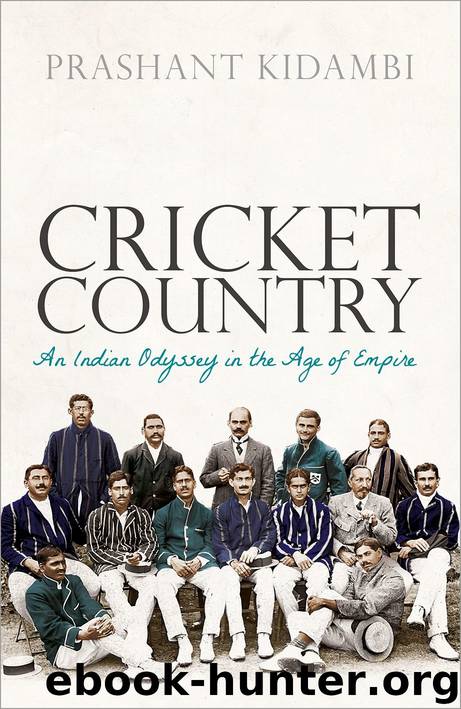Cricket Country by Prashant Kidambi

Author:Prashant Kidambi [Kidambi, Prashant]
Language: eng
Format: epub
ISBN: 9780192581112
Publisher: OUP Oxford
Published: 2019-07-11T00:00:00+00:00
8
Indian Summer
I
The Indian cricketers were not the only international sportsmen on show in Britain that summer. They formed part of an extraordinary conjunction that saw the arrival in London of athletes from across the world. The simultaneous presence in the city of these sportsmen was a function of the increasingly transnational character of sport in the age of imperial globalization. In a world on the move, sportsmen too were now able to parade their skills outside their homelands. And for many of them, as we shall see, London was the centre of the sporting world.
Around the same time as the Indian cricketers, sporting contingents from the ‘white dominions’ came to Britain to take part in the first ever intra-imperial sports championships.1 Held in late June as an adjunct to the Festival of Empire, teams representing Great Britain, Canada, and ‘Australasia’ (a combination from Australia and New Zealand) competed against each other in track and field, ring, and swimming events. The organizers had originally intended to include India and South Africa in these imperial games. But Australia was opposed to the participation of ‘non-whites’ in the competition and the idea was jettisoned. The Canadian contingent emerged as the victors and took home the newly established Lonsdale Cup.
The press coverage of the Festival of Empire games was tepid; the event aroused little public interest. In sharp contrast, the arrival on British shores of the controversial African-American boxer Jack Johnson generated an intense buzz in the press. The optics and ramifications of Johnson’s visit differed significantly from the other sportsmen who came to Britain in the summer of 1911. The previous July, Johnson had demolished Jim Jeffries—the American ‘Great White Hope’—and retained his status as the world’s first black heavyweight champion.2 Staged in the ‘Sin City’ of Reno, Nevada, the Jeffries-Johnson encounter was the most eagerly anticipated sporting event of its time. Billed as the ‘battle of the century’, the contest brought to the fore a new type of ‘commercialized racial spectacle’ whose profitability was directly proportional to its publicity. The fight generated more news over the wires than ‘the fall of Port Arthur during the Russo-Japanese War’.3 Johnson’s fight with Jeffries was also filmed and the prints and images made their way around the world. This triggered a backlash among white communities across the United States, the British Empire, and Europe. A transnational alliance of conservative white politicians, pastors, reformers, bureaucrats, newspaper editors, and concerned citizens launched a vociferous campaign to ban a film that threatened to undermine the established racial hierarchy.4
It was against this fractious backdrop that Johnson travelled to Britain in the first week of June 1911. In London, the world’s greatest boxer put on a display of choreographed extravagance.5 He also attracted large crowds wherever he went. On Coronation Day, his car was mobbed by spectators outside Westminster Abbey.6 After the imperial festivities ended, Johnson ‘became a sellout sensation in London’s music halls’, entertaining audiences with his boxing routines and his beloved bass viol.7
Predictably, Jack Johnson’s presence in Britain dominated the newspaper headlines.
Download
This site does not store any files on its server. We only index and link to content provided by other sites. Please contact the content providers to delete copyright contents if any and email us, we'll remove relevant links or contents immediately.
| Cricket | Field Hockey |
| Lacrosse | Rugby |
| Track & Field | Volleyball |
Going Long by Editors of Runner's World(1920)
The Happy Runner by David Roche(1819)
Yoga For Dummies by Georg Feuerstein(1208)
Legacy by Kerr James(1056)
Becoming Boston Strong by Amy Noelle Roe(1022)
Winger by Smith Andrew(998)
The Little Red Book of Running by Scott Douglas(884)
Bowerman and the Men of Oregon by Kenny Moore(883)
Wodehouse At the Wicket by P.G. Wodehouse(865)
5050 by Dean Karnazes(839)
The Way of the Runner by Adharanand Finn(834)
Running Your First Marathon by Andrew Kastor(830)
Swim, Bike, Run - Eat by Tom Holland(828)
The Coming Storm by Nigel McCrery(778)
Spiked (Blocked Book 3) by Jennifer Lane(771)
Blade Runner by Oscar Pistorius(755)
The Shared Origins of Football, Rugby, and Soccer by Christopher Rowley(750)
The Grade Cricketer by Dave Edwards(747)
The Amazing Test Match Crime by Adrian Alington(747)
